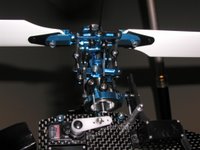The last steps involve programming the ESC, Setting up the gyro for heading hold, and creating throttle and pitch curves in the radio. To setup the ESC you must have the throttle stick in low position before you power the heli, once you do this you hear a series of beeps that indicate to the user which settings they have. I will not go into what all mean. One of the coolest things about this setup is the Gyroscope. The Gyro automatically adjusts the pitch of the tail rotors to compensate for the change in heading. So, whithout any stick input from me, if I move the tail to the right the tail pitch compensated by itself, and then when the movement stops the pitch returns to center. Is cooler than it sounds. I am not going to try and explain throttle curves.
Here is a quick little vid of my bird.
Money in the pit:
$56.85 Parts and tools from Readyheli.com
Total so far $1589.20
Tech.ses.sion --Compulsive preoccupation with a fixed idea or an unwanted feeling or emotion, often accompanied by symptoms of euphoria brought on by technology.
This blog will contain posts related to what I am currently wasting money on, what I plan to be wasting money on, and what I wish I could be wasting money on, usually centered on or around technology.
Thursday, September 07, 2006
T-Rex - Tuning the head
Well after waiting around for that receiver crystal (no not Dilithium)to show up in the mail and driving all over Connecticut looking for one, I had the brilliant idea to try the crystals from my other copter and guess what! they worked!! yeah so All in all it was a good thing because it gave me time to paint the canopies.
Ok, so the next step in the build process is to setup the servos, control arms and links to make the head operate properly and to allow the bird to fly smoothly. What a frigging pain in the Ass! It took me 2+ days to do this and I am still not completely satisfied. I will try to explain this process but I may not make sense. Ok the servo moves the linkages to the swashplate and that in turn changes the attitude of the helicopter. The linkages also control the pitch of the blades ot either increase or decrease the rate of climb. The trick to this head setup is to get all of the links to work together and control the heli. Lets just say it sounds easier than it is. I was cooked after this step, but I trudged on.


Ok, so the next step in the build process is to setup the servos, control arms and links to make the head operate properly and to allow the bird to fly smoothly. What a frigging pain in the Ass! It took me 2+ days to do this and I am still not completely satisfied. I will try to explain this process but I may not make sense. Ok the servo moves the linkages to the swashplate and that in turn changes the attitude of the helicopter. The linkages also control the pitch of the blades ot either increase or decrease the rate of climb. The trick to this head setup is to get all of the links to work together and control the heli. Lets just say it sounds easier than it is. I was cooked after this step, but I trudged on.


Subscribe to:
Comments (Atom)